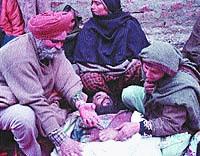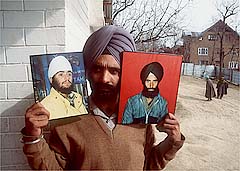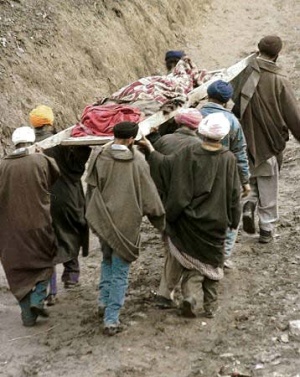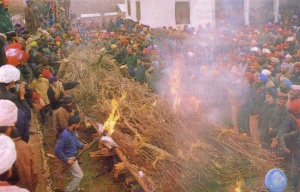Chittisinghpura Massacre
The Chittisinghpura Massacre refers to the cold blooded murder of 35 Sikhs, which occurred on the evening of March 20, 2000 at small Jammu and Kashmir village called "Chittisinghpura". The massacre was carried out by about 20 unidentified terrorists though a member of the Islamic Fundamentalist militant group Lashkar-e-Toiba ("LeT") has confessed to their involvement in the massacre. According to Amnesty International, the massacre was linked to other massacres in the region where the people have doubted the government's account of the story. 1
Several witnesses have said that about 20 men, clad in olive green combat fatigues, arrived in the village at 7-15 p.m. They told the people that they were Indian soldiers, and ordered the men out to be questioned. The captors spoke Urdu. The village men were lined up in two groups, a few hundred metres from each other. One of the captive men who had been lined up recognised someone among the gunmen. He asked, "Chattiya, tu idhar kya kar raha hai?" ("Chattia, What are you doing here?"). The person he spoke to immediately opened fire. At the same time all captors began firing. As they started firing, the gunmen shouted 'Jai Mata Di' and 'Jai Hind'. In theatrical fashion, one of them took swigs from a bottle of rum even as the killing went on. While leaving, one of the men called out to his associates: "Gopal, chalo hamare saath" ("Gopal, Come with us").
The Killings
Wearing Indian Army fatigues to avoid detection the killers, in two groups, first lined the Sikhs, who had been celebrating the Hola Mahalla Festival, up in front of the village's two Gurdwaras and opened fire, resulting in a large number of deaths.
The sole survivor of the massacre was Nanak Singh, who was shot in the pelvis and laid unconscious on the pile of bodies. He recalled hearing the terrorists laughing over their deeds while sending a 'mission accomplished' message over their walkie-talkie. His sons Gurmeet Singh (16) and brother Darbari Singh (30) and three first cousins were among the dead. His oldest son was away at the time.
The village did not have a telephone, some boys who came on the scene had to run 7 km, over a mud (kuchha) road, to reach a phone and summon help. As of 2007 Chittisinghpura was still not connected with a metalled road.
Lashkar-e-Toiba suspected
The residents were killed supposedly by LeT as part of their Islamist campaign in the region. A LeT militant named Suhail Malik of Sialkot, who was arrested in December of the same year, admitted, according to a rediff news report, to the involvement of the group saying he had no regret in perpetrating the anti-Sikh massacre. Malik apparently said he had opened fire because he had been ordered to do so by his commanders. He also said that he knew nothing about the plot to kill the Sikhs until he stood in an orchard where the 35 people were killed.
Lashkar-e-Toiba had taught Malik marksmanship and mountain climbing. He sneaked into India in October of 1999, with the equivalent of USD 200 in expense money, in order to participate in the massacre.
Aftermath
The killings of 36 Sikhs was a turning point in the Kashmir issue, as Sikhs had usually been spared of militant violence.
The villagers ensured that the local school was up and running just two weeks after the killings. The massacre created suspicion between the Sikh and Muslim residents of the area, but no problems developed in the joint Muslim-Sikh village school.
In 2005, Sikh organizations such as the Bhai Kanhaiya Jee Nishkam Seva Society demanded a deeper state inquiry into the details of the massacre and that the inquiry be made public. The state government ordered an inquiry into the massacre. A day after the inquiry was ordered, an NDTV special correspondent Barkha Dutt went to the village. 2 Tribune News November 11, 2005]
The Clinton Controversy
The massacre coincided with the visit of United States president Bill Clinton to India. In an introduction to a book written by Madeleine Albright titled, "The Mighty and the Almighty: Reflections on America, God, and World Affairs", (2006), President Clinton in the preface blamed the massacre on "Hindu Militants". The error created a major incident, with both Hindu and Sikh groups expressing outrage at the error. The President's office did not return calls seeking comment or clarification. In the hours immediately after the massacre in March 2000, the US condemned the killings but refused to accept the Indian governments contention that it was the work of Pakistan based Islamist groups. That changed as soon as Clinton's error was exposed. The publishers, Harper Collins routed a correction through Albright's office. In a public statement they acknowledged the error.
Page xi of the book contains a reference to Hindu militants that will be deleted in subsequent printings, both in America and in international editions. This error was due to a failure in the fact-checking process. President Clinton has been known for making statements he later regretted.
Mishra Controversy
The apparent error was aggrandized by Clinton's refusal to acknowledge it, and exacerbated by Pankaj Mishra's book, "Temptations of the West: How to be Modern in India, Pakistan, Tibet and Beyond", where he repeated the allegations against "Hindu Militants" even after the confession of the Lashkar-e-Toiba militant.
Chittisinghpura massacre in film
The massacre was depicted in the commercial Bollywood film Adharm (unholy) directed by Adeep Singh.
In the news
The massacre still haunts him
Tribune News Service S.P. Sharma Nanak SinghJammu, March 17, 2007
Seven years have passed since the massacre of 35 Sikhs by unidentified terrorists at Chittisinghpura but Nanak Singh, the lone survivor of the brutal attack, still has fresh in his mind memories of the incident. Residents of this village will observe the seventh anniversary of the massacre on March 20 even as the Army and CRPF have been deployed in and around the village in Kashmir.
Just a reminder of the brutal incident in which his 16-year-old son Gurmeet Singh, brother Darbari Singh (30) and three first cousins lay dead in a pool of blood sends shivers through his spine. He always carries the photo of Gurmeet Singh in his wallet. His elder son was fortunately out of the village at that time.
Nanak Singh himself lay unconscious on the heap of bodies as he was also shot in the pelvis. He recalls that the 12 terrorists were laughing and sending a signal of “mission accomplished” on the walkie-talkie to someone after the massacre. He was taken to the district hospital at Anantnag and later shifted to Srinagar.
He recalls that it was about 7.45 p.m. and it was drizzling after the village folk had celebrated Holi when two groups of gunmen barged into the village and asked the Sikhs to line up outside the two gurdwaras. Thereafter, they were fired at indiscriminately. Screams of women and children echoed in the village till the next morning when the security forces reached there.
Nanak laments that although seven years have passed but the government has not bothered to order a probe into the massacre. In contrast, the government lost no time in ordering a CBI probe and punishing the guilty Army and police personnel involved in the killing of five persons belonging to the majority community at Pathribal that is just a stone throw away from Chittisinghpura. “Is it a sin to belong to the minority community. I am still feeling insecure and the government has not bothered to provide security to my family,” he said. Nanak Singh says that several top leaders from Delhi and Srinagar visited the village to shed crocodile tears the very next day but they forgot the promises made to the widows once they flew back through the Pir-Panchal ranges.
The village does not have a telephone and the boys had to run 7 km to make a telephone call to inform the police about the massacre. Moreover, the roads to the neighbouring villages inhabited by the majority community are metalled, but Chittisinghpura continues to be linked by a kuchha road, he added.
See also
- Clinton's thoughts on the Chittisinghpura Massacre
- Lashkar militant admits killing Sikhs in Chittisinghpura
- A Kashmiri Mystery
- Chittisinghpura murder of Sikhs : Letter from SAD (A)
- The massacre at Chattisinghpora
External links
- AMNESTY INTERNATIONAL - India: A trail of unlawful killings in Jammu and Kashmir: Chithisinghpora and its aftermath
- NEW YORK TIMES - A Kashmiri Mystery





